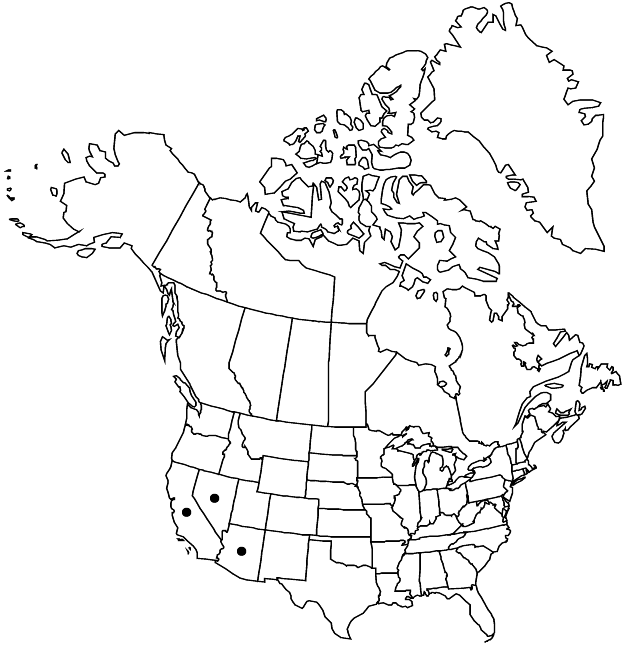Difference between revisions of "Eriogonum heermannii var. argense"
Aliso 4: 89. 1958.
FNA>Volume Importer |
imported>Volume Importer |
||
| (4 intermediate revisions by one other user not shown) | |||
| Line 8: | Line 8: | ||
}} | }} | ||
|common_names=Heermann’s rough wild buckwheat | |common_names=Heermann’s rough wild buckwheat | ||
| − | |basionyms={{Treatment/ID/ | + | |special_status={{Treatment/ID/Special_status |
| + | |code=E | ||
| + | |label=Endemic | ||
| + | }} | ||
| + | |basionyms={{Treatment/ID/Basionym | ||
|name=Eriogonum sulcatum var. argense | |name=Eriogonum sulcatum var. argense | ||
|authority=M. E. Jones | |authority=M. E. Jones | ||
| + | |rank=variety | ||
| + | |publication_title=Contr. W. Bot. | ||
| + | |publication_place=11: 15. 1903 | ||
}} | }} | ||
|synonyms={{Treatment/ID/Synonym | |synonyms={{Treatment/ID/Synonym | ||
|name=Eriogonum apachense | |name=Eriogonum apachense | ||
|authority=Reveal | |authority=Reveal | ||
| + | |rank=species | ||
}} {{Treatment/ID/Synonym | }} {{Treatment/ID/Synonym | ||
|name=Eriogonum heermannii subsp. argense | |name=Eriogonum heermannii subsp. argense | ||
|authority=(M. E. Jones) Munz | |authority=(M. E. Jones) Munz | ||
| + | |rank=subspecies | ||
}} {{Treatment/ID/Synonym | }} {{Treatment/ID/Synonym | ||
|name=Eriogonum heermannii var. subracemosum | |name=Eriogonum heermannii var. subracemosum | ||
|authority=(S. Stokes) Reveal | |authority=(S. Stokes) Reveal | ||
| + | |rank=variety | ||
}} {{Treatment/ID/Synonym | }} {{Treatment/ID/Synonym | ||
|name=Eriogonum howellii | |name=Eriogonum howellii | ||
| − | |authority= | + | |authority= |
| + | |rank=species | ||
}} {{Treatment/ID/Synonym | }} {{Treatment/ID/Synonym | ||
|name=Eriogonum howellii var. subracemosum | |name=Eriogonum howellii var. subracemosum | ||
|authority=S. Stokes | |authority=S. Stokes | ||
| + | |rank=variety | ||
}} | }} | ||
|hierarchy=Polygonaceae;Polygonaceae subfam. Eriogonoideae;Eriogonum;Eriogonum subg. Eucycla;Eriogonum heermannii;Eriogonum heermannii var. argense | |hierarchy=Polygonaceae;Polygonaceae subfam. Eriogonoideae;Eriogonum;Eriogonum subg. Eucycla;Eriogonum heermannii;Eriogonum heermannii var. argense | ||
| Line 52: | Line 64: | ||
-->{{#Taxon: | -->{{#Taxon: | ||
name=Eriogonum heermannii var. argense | name=Eriogonum heermannii var. argense | ||
| − | |||
|authority=(M. E. Jones) Munz | |authority=(M. E. Jones) Munz | ||
|rank=variety | |rank=variety | ||
| Line 66: | Line 77: | ||
|publication title=Aliso | |publication title=Aliso | ||
|publication year=1958 | |publication year=1958 | ||
| − | |special status= | + | |special status=Endemic |
| − | |source xml=https:// | + | |source xml=https://bitbucket.org/aafc-mbb/fna-data-curation/src/2e0870ddd59836b60bcf96646a41e87ea5a5943a/coarse_grained_fna_xml/V5/V5_609.xml |
|subfamily=Polygonaceae subfam. Eriogonoideae | |subfamily=Polygonaceae subfam. Eriogonoideae | ||
|genus=Eriogonum | |genus=Eriogonum | ||
Latest revision as of 22:12, 5 November 2020
Shrubs, spreading to rounded, sparsely to densely branched, 1–10 × 2–10(–12) dm. Leaf blades linear to linear-lanceolate or oblanceolate to elliptic or oblong, 0.5–1.2(–1.5) × 0.1–0.6 cm, tomentose or glabrous abaxially. Inflorescences (1–)3–20 × (1–)3–25 cm; branches diffuse with racemosely arranged involucres at tips, slender to stout, round, smooth, glabrous, scabrellous, or infrequently papillate-scabrous, infrequently somewhat spinose. Involucres narrowly turbinate to campanulate, 0.9–1.8 × 0.7–1.3 mm. Flowers 1.5–4 mm; perianth white to yellowish white or reddish.
Phenology: Flowering Apr–Nov.
Habitat: Limestone (rarely volcanic) cliffs, outcrops, and washes, or on gypsophilous outcrops, saltbush, blackbrush, sagebrush, and mountain mahogany communities, pinyon-juniper and montane conifer woodlands
Elevation: 800-2800 m
Distribution

Ariz., Calif., Nev.
Discussion
Variety argense is widespread and occasionally locally common. It is found in the Mohave Desert from Inyo County south through San Bernardino County to northern Riverside County, California, then eastward across Nevada in northern Clark, Esmeralda, Lincoln, Nye, and White Pine counties, into Coconino, Mohave, Navajo counties, Arizona. It just enters the Sonoran Desert in Yavapai County, Arizona, and is disjunct farther to the east in Graham and Gila counties. A population near Vail (Gila County) sampled by M. E. Jones in 1903 (DS, POM, US) has not been rediscovered, although the variety is known from Pueblo Canyon in the Sierra Ancha (Wagner 320, DUKE).
The scabrellous condition of the inflorescence branches of this variety can be obscure, occasionally leading to its misidentification as var. heermannii. The flowering stems and inflorescence branches are always rounded, not angled or ribbed as in var. sulcatum, but the latter condition is sometimes difficult to see, resulting in plants of that variety being misidentified as var. argense. Specimens from above the Little Colorado River, and along the Colorado River near the mouth of the Little Colorado, with stout, often pointed branches have been distinguished as var. subracemosum. They are low, spreading, and usually sparsely branched, unlike the typical expressions of var. argense. Based on herbarium specimens, it appears that var. subracemosum merges completely with classical var. argense on the cliff faces above the Colorado River on and to the east of the Kaibab Plateau. The disjunct Eriogonum apachense of gypsophilous outcrops northwest of Bylas in Graham County, Arizona, differs little from plants found on limestone ledges and slopes in the White Hills of Yavapai County. By and large, the involucres of typical E. apachense are narrowly turbinate, the leaf blades remain tomentose on the abaxial surface, and the inflorescence branches are decidedly more slender. The reduction of E. apachense seems justified, resulting in a var. argense that is highly variable but nonetheless easy to distinguish.
Selected References
None.